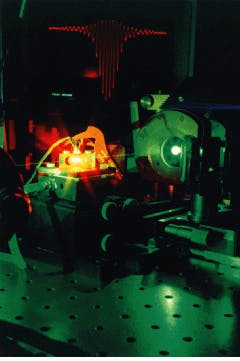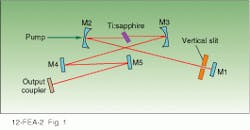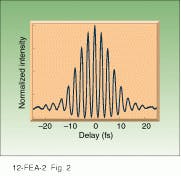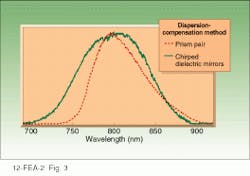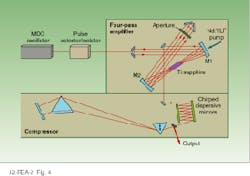Chirped dielectric mirrors improve Ti:sapphire lasers
High-quality seed pulses from mirror-dispersion-controlled Ti:sapphire system allow chirped pulse amplification without a pulse stretcher.
Ch. Spielmann, M. Lenzner, F. Krausz, R. Szip?cs, and K. Ferencz
Titanium-doped sapphire (Ti:sapphire) is probably the most successful laser medium used in ultrafast lasers because of its broad gain bandwidth (approximately 200 nm FWHM) and excellent mechanical and thermal properties. The discovery of self- or Kerr-lens modelocking has also opened the way to an efficient exploitation of its enormous optical bandwidth for ultrashort pulse generation.1,2
Commercial self-modelocked Ti:sapphire lasers, offering average output powers up to 2 W and pulse durations as low as 50 fs, are now commonplace in ultrafast laboratories. The Ti:sapphire medium is also well suited for extracavity amplification, yielding high-power femtosecond pulses. Several manufacturers offer Ti:sapphire oscillator-amplifier systems that can produce pulses in the 100-fs range with terawatt peak powers and repetition rates of 10 Hz or less. Whereas these femtosecond commercial systems represent dramatic progress in terms of reliability, lifetime, and peak power, the pulse duration they offer is not significantly shorter than that available from the previous-generation, dye-laser-based systems. Nevertheless, the broad bandwidth of Ti:sapphire and the ultrafast response of the Kerr effect potentially allow the generation of substantially shorter pulses.
The motivation for further decreasing pulse durations comes from a number of fields. Researchers often need to achieve high powers without producing excessive pulse energies that cause damage to solid targets. In reversible optical experiments, metals, semiconductors, and insulators can be exposed to femtosecond pulses with intensities orders-of-magnitude higher than practicable with picosecond pulses. In moderate-intensity spectroscopy, pulse duration determines the achievable time resolution of pump-probe experiments.
Sub-100-fs time resolution, available since the early 1980s, is usually sufficient to O?freeze?? the rotational and vibrational dynamics of complex atomic systems such as molecules, clusters, and condensed matter, and even the motion of sufficiently heavy atoms in chemical processes. Microscopic dynamics, however, often take place on a time scale of roughly 10 fs or less. For instance, the study of coherent light-matter interaction, which provides information about the coupling of atoms, ions, and molecules to their surroundings, calls for sub-10-fs time resolution. Under certain circumstances, femtosecond optical pulses might permit the study of electron motion, for example, tracing out the evolution of the electronic wave function in atomic systems. Reliable ultrafast sources capable of producing high-quality, sub-10-fs pulses would thus be useful tools for fundamental materials research.
In a self-modelocked Ti:sapphire laser, intracavity aperturing and self-focusing in the laser crystal act as a fast saturable absorber and yield ultrashort pulses. In the femtosecond regime, however, this effect is too weak to compensate for the pulse broadening caused by the interplay between self-phase modulation and positive-cavity group delay dispersion (GDD). This undesirable effect can be avoided by introducing a pair of Brewster-angled prisms as a source of negative GDD in the cavity.3
A net negative-cavity GDD translates the broadening effect into an efficient pulse-shortening process, often referred to as soliton-like shaping. Under these conditions, the finite gain and oscillator bandwidth represent the only limitations to pulse broadening. Interestingly, these mechanisms only come into play when pulse durations drop below 10 fs, prompting researchers to question what limited the steady-state pulse duration to greater than 50 fs in the first systems demonstrated.
Improving performance
Soon after the first dispersion-controlled self-modelocked Ti:sapphire lasers had been put into operation, researchers recognized that system performance depends critically on the bandwidth DnGDD over which the overall (negative) cavity GDD is approximately constant. The finite value of DnGDD relates to undesirable higher-order dispersion introduced mainly by the prism pair itself. The highly dispersive SF 10 prism pair (Schott Glass Technologies, Duryea, PA) used in the first demonstrations and in almost all commercial femtosecond Ti:sapphire oscillators typically limits DnGDD to less than 10 THz due to strong third-order, or cubic, dispersion in the 800-nm range.
Systems with reduced cubic-dispersion prisms achieved shorter pulse durations, pointing to the performance-limiting role of of DnGDD. These findings led to the substitution of fused-silica prisms, which introduced the lowest cubic phase distortion around 800 nm among commercial optical materials.3
Ti:sapphire systems incorporating fused-silica prisms can produce nearly ideal, bandwidth-limited, secant-hyperbolic-shaped pulses as short as 15 fs. As pulse duration approaches 10 fs, the spectrum becomes increasingly asymmetric, implying the emergence of a pedestal (increased amplitude in the envelope wings) in the time domain. Pulses near or slightly below 10 fs can only be achieved at the expense of pulse quality and detuning to approximately 850 nm from the gain peak at 790 nm. The time-bandwidth product for these pulses is 0.6, nearly double the value of 0.32 for a bandwidth-limited hyperbolic secant (sech) pulse.4
The rapid degradation in pulse quality for pulsewidths approaching 10 fs results from residual higher-order dispersion of the prisms and the finite high-reflectivity bandwidth of the quarter-wave dielectric mirrors in prism-controlled Ti:sapphire lasers. Another problem inherent to these systems is increased pulsewidth sensitivity to cavity and prism alignment. Cavity-mirror alignment changes the position of the resonator axis and thus the glass path length through the prisms. Hence, to maintain pulsewidth, even small cavity realignments necessitate subsequent readjustment of the prism positions and orientations. This prevents turnkey operation of prism-controlled oscillators producing pulses in the 10-fs range and makes a day-to-day reproduction of optimum performance time-consuming.
Dispersion control with mirrors
To address these drawbacks, we have developed dispersion-controlled mirrors that offer broadband feedback and dispersion control in ultrafast Ti:sapphire systems by imparting negative dispersion over a broad spectral range. These elements can permit generation of shorter, higher-quality pulses than previously achievable, while addressing the limitations of prism-controlled systems and reducing cavity sizes.
Dispersion-controlled, or chirped, mirrors are essentially modified quarter-wave dielectric mirrors in which the multilayer period is modulated across the mirror structure, creating a wavelength-dependent optical field penetration depth.5 A nearly constant negative dispersion is achieved over an extremely broad wavelength range, exceeding the largest DnGDD achievable with prisms. In addition, the layer period modulation also significantly broadens the high-reflectivity bandwidth of the chirped structures as compared to standard quarter-wave mirrors. Mirror-dispersion-controlled (MDC) oscillators without prisms can thus support shorter pulses than their prism-controlled predecessors (see Fig. 1).
First demonstrated in 1993 by the Abteilung Quantenelektronik and Lasertechnik, Technische Universit?t (AQL/ TUV, Vienna, Austria) in collaboration with the Optical Coating Laboratory at the Research Institute for Solid State Physics (Budapest, Hungary), MDC technology has matured. The MDC Ti:sapphire oscillator illustrated incorporates chirped mirrors with a high reflectivity over the spectral range from 670 to 930 nm and a roughly constant negative GDD between 720 and 890 nm, corresponding to a DnGDD > 80 THz (see photo on p. 55 and cover). Aside from the gain medium, a highly doped 2.5-mm-thick Ti:sapphire crystal, the only other elements in the cavity are an output coupler and a vertical slit for Kerr-lens modelocking. Three watts of pump power (all lines) from an Innova 310 argon-ion laser (Coherent, Santa Clara, CA) are sufficient for stable modelocked operation with a typical average output power of 100 mW at an 80-MHz repetition rate.
The optimized MDC Ti:sapphire oscillator is capable of producing bandwidth-limited pulses with durations as low as 8 fs, with a time-bandwidth product of 0.38 (see Fig. 2).6 It is also important to note that sub-10-fs performance, achieved with a bandwidth typically between 90 and 100 nm, is centered about the peak of the Ti:sapphire gain region (l0 = 790 to 800 nm). By contrast, prism-controlled Ti:sapphire
oscillators offer comparable time resolution only at the expense of a red-shifted, substantially broader spectrum
(Dl = 160?170 nm, l0 = 850 nm).4
Near the gain-line center, the modelocked bandwidth of a quartz-prism-controlled Ti:sapphire laser is limited by cubic dispersion to approximately
70 nm, corresponding to a pulsewidth of 11 to 12 fs. When spectra from the two systems are compared, the improved pulse quality and reduced duration of the MDC system are clearly apparent (see Fig. 3).
High-quality pulses improve time-resolved spectroscopy applications in which optimum spectral purity is desired. Coincidence of the pulse spectrum with the peak of the Ti:sapphire gain line, on the other hand, is important for seeding Ti:sapphire amplifiers.
Many applications require higher peak powers than modelocked oscillators can provide; solid-state short-pulse amplifiers with the same broadband gain medium as the seed system can provide the desired power boost. To avoid optical damage and nonlinear effects in the amplifier system, the peak power of the seed pulses must be reduced by pulse broadening prior to injection (chirped pulse amplification).7 Though the use of a sophisticated pulse stretcher is unavoidable in terawatt-scale systems, the sub-10-fs pulses at Ti:sapphire gain-line center produced by the MDC oscillator can make a dispersive optical delay line unnecessary.8
At AQL/TUV, we recently demonstrated a Ti:sapphire amplifier system that uses no additional pulse stretcher, producing multigigawatt-peak-power output at kilohertz repetition rates. We believe that this is the first time such a system has been reported. The seed pulses broaden by a factor of 300 after traversing the pulse selection and isolation system; peak power is sufficiently reduced to avoid nonlinear effects in a moderate-energy (millijoule level) system (see Fig. 4). The pulses are amplified in a four-pass confocal amplifier; they then pass through a compressor comprising FK5 prisms and a pair of chirped mirrors designed for cubic dispersion compensation. Because of the low-loss expansion/compression system and the absence of phase aberrations up to the fourth order, the Ti:sapphire MDC oscillator-amplifier system yields nearly bandwidth-limited, multigigawatt 17- to 18-fs pulses at kilohertz repetition rates.9
The currently available pulse energy of 100 ?J (at 1 kHz) can be boosted to the millijoule level if a further amplifier stage is added. Its unique performance and reliability make this compact, unprecedently simple system a powerful tool for ultrafast spectroscopy and nonlinear optics.
The invention of Ti:sapphire and its development to a top-quality laser crystal, together with the appearance of novel techniques for laser modelocking and dispersion compensation, have revolutionized ultrafast laser technology. Now chirped dielectric mirrors offer the potential of even shorter pulses and may make turnkey ultrafast Ti:sapphire systems a reality. n
ACKNOWLEDGMENTS
The contributions of A. Stingl, L. Xu, and S. Sartania to the presented results are gratefully acknowledged. This work was supported by the Austrian and Hungarian Science Foundations under grants P9710, P10409, and T7376, and by the Ministry of Science and Research in Austria.
REFERENCES
1. D. E. Spence, P. N. Kean, and W. Sibbett, Opt. Lett. 16, 32 (1991).
2. U. Keller et al., Opt. Lett. 16, 1022 (1991); L. Spinelli et al., Proc. CLEO 1991, PDP7, Optical Society of America, Washington DC (1991).
3. P. F. Curley et al., Opt. Lett. 18, 54 (1993); B. Proctor and F. Wise, Appl. Phys. Lett. 62, 470
(1993); M. Asaki et al., Opt. Lett. 18, 977 (1993).
4. Ch. Spielmann, P. F. Curley, T. Brabec, and F. Krausz, IEEE J. Quantum Electron. 30, 1100 (1994); J. Zhou et al., Opt. Lett. 19, 1149 (1994).
5. R. Szip?cs, K. Ferencz, Ch. Spielmann, and F. Krausz, Opt. Lett. 19, 201 (1994).
6. A. Stingl et al., Opt. Lett. 20, 602 (1995).
7. D. Strickland and G. Mourou, Opt. Commun. 56, 219 (1985).
8. C. P. J. Barty, C. L. Gordon, and B. E. Lemoff, Opt. Lett. 19, 1442 (1994).
9. M. Lenzner et al., Opt. Lett. 20, 1397 (1995).
Multipass Ti:sapphire amplifier is seeded with high-quality 8-fs pulses generated
by a Ti:sapphire oscillator incorporating chirped dielectric mirrors for dispersion compensation.
FIGURE 1. Femtosecond Ti:sapphire laser uses chirped dispersive mirrors (M1?M5) for intracavity dispersion compensation.
FIGURE 2. Pulses of 8.5 fs are produced by Ti:sapphire laser incorporating chirped mirrors. Single-scan, fringe-resolved autocorrelation trace shows the quality of pulses routinely obtained from system.
FIGURE 3. Comparison of spectra from prism-controlled and chirped-
mirror Ti:sapphire oscillators reveals enhanced performance of chirped-mirror system, which yields a more symmetric pulse.
FIGURE 4. Four-pass kilohertz Ti:sapphire amplifier produces 18-fs pulses with an energy of 100 ?J (after compression) when pumped with 6-mJ pulses from a frequency-doubled Nd:YLF laser.
